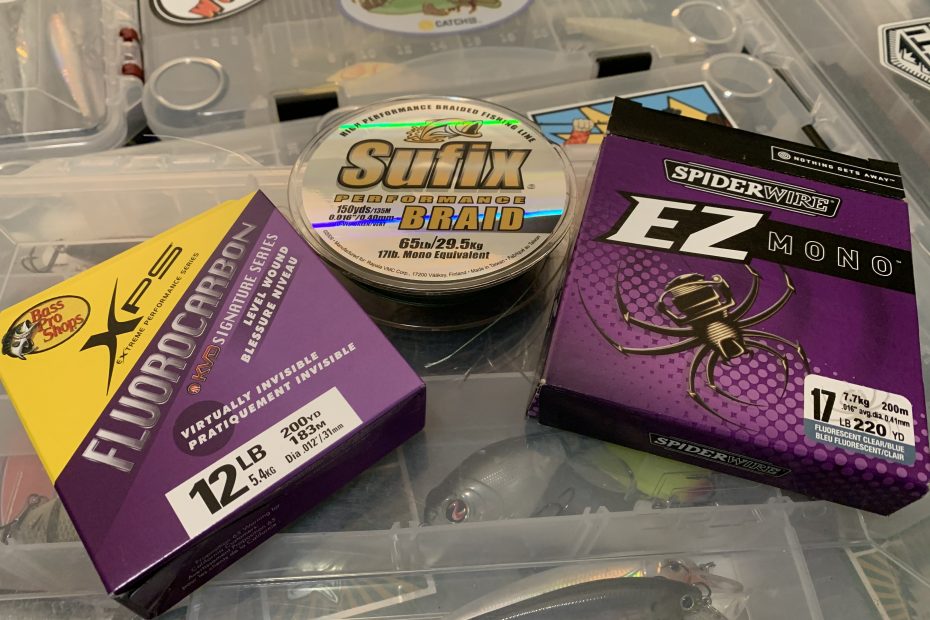Fluorocarbon, Monofilament, and braid. What is the difference? Does it even matter what I throw? This is a question people ask all the time, and many of us dont seem to care. Well Im here to tell you that you should care and that your success on the water can change drastically based on the type of line your throwing. Lets go over what the different types of line are, where to throw them, why to throw all three.
Fluorocarbon
Fluoro is a low visibility, sinking line that features low stretch and great castability. It has the advantage when you dont want the fish to see your line. Finesse presentations like drop shots, shaky heads, and ned rigs are perfect cases when you should throw fluoro. Since fluoro sinks, it is also good for baits that you want to get down to their correct depth or the bottom. Crankbaits, spinnerbaits, and swimbaits fall into this category, as well as bottom baits such as jigs, Texas rigs, and Carolina rigs.
Monofilament
Mono is a tinted line that is somewhat visible, that floats and has a lot of stretch. It has the worst castability out of the three types of line. However, it is good for topwater baits due to the fact it floats and doesnt pull your bait under while working it. It is also good to use for moving baits if you want to have more play when fighting fish, or if youre worried that your rod will overpower a lure and you want the mono to act as a shock absorber, so you dont break off. But you need to remember that the same stretch that acts as a shock absorber in some cases, can also lead to back hooksets in some situations.
Braided Line
Braid is a visible line that floats and has zero stretch. It has great castability in smaller diameters such as 30-40 pound test but is more susceptible to bad backlashes that are harder to get out. It is made by weaving fibers together to create a super strong, small diameter line. This small diameter means that you will typically want to throw a larger pound test then you usually throw so that the line doesnt dig into itself on your spool.
Now the perks of this is that you can throw really strong line for when in heavy cover. 50-65 lb braid can be used to punch in grass, flip and pitch in heavy cover, throw frogs, as well as throw bigger baits. The zero-stretch means that when paired with a heavier action rod, you can get a strong hookset on baits that are in difficult places to get fish out of, and with baits that are difficult to get good hook penetration.
What line to Throw When
So when do we throw each type of line, and why should we care about when we throw them? Well consider where you fish, what baits your throwing, and what types of rods your throwing and match accordingly. Throw braid when fishing heavier cover and topwater baits. Fish mono when you throw topwater baits, want to fish a bait higher in the water column, or want more play so as to not rip hooks out when fighting fish. Throw fluoro when fishing baits when you don’t want fish to see your line, when you need to make long cast and need a good hookset, and when you need to get a bait down to the bottom. Match the pound test of all of these (braid you can go heavier then listed) based off of the rating your rod has listed (almost all rods tell you line and lure weight recommendations).
Based off of the waters I fish and the style that I fish, I throw almost all fluoro. I will have one or two baitcasting rods with braid, or one with braid and one with mono. But this is mostly just for topwater though, so I may throw all fluoro based on the season. On my spinning rods I throw braid to a fluorocarbon or mono leader.
Heres a list of baits I throw on each type of line:
- Fluoro (braid to fluoro leader) 8-20 lb test: All treble hooked baits (besides topwater), spinnerbaits, chatterbaits, jigs, dropshots, shaky heads, Texas rigs, Carolina rigs, ned rigs, neko rigs, and swimbaits.
- Mono (braid to mono) 10-17 lb test: All topwater, spinnerbaits, treble hook baits (EXCEPT Jerkbaits), and bigger swimbaits.
- Braid 40-65 lb test: Frogs, Chatterbaits, Heavier jigs and Texas rigs, and topwater.
Now obviously this can change for you based off of what type of water you typically fish. A friend of mine fishes the Potomac River a lot, which is a grass filled, tidal fishery. He throws braid for just about everything. If your down to one rod, pick whichever line you can do the most with the type of rod you throw, or consider utilizing braid to fluoro/mono leaders to use all three. Ultimately, you know how you like to fish, but hopefully this article will equip you with some information to better match you line with your rods, and lures, so that you can properly use them, and affectively land fish with them the next time you get out fishing.
See below for some of the fishing line brands we recommend:
